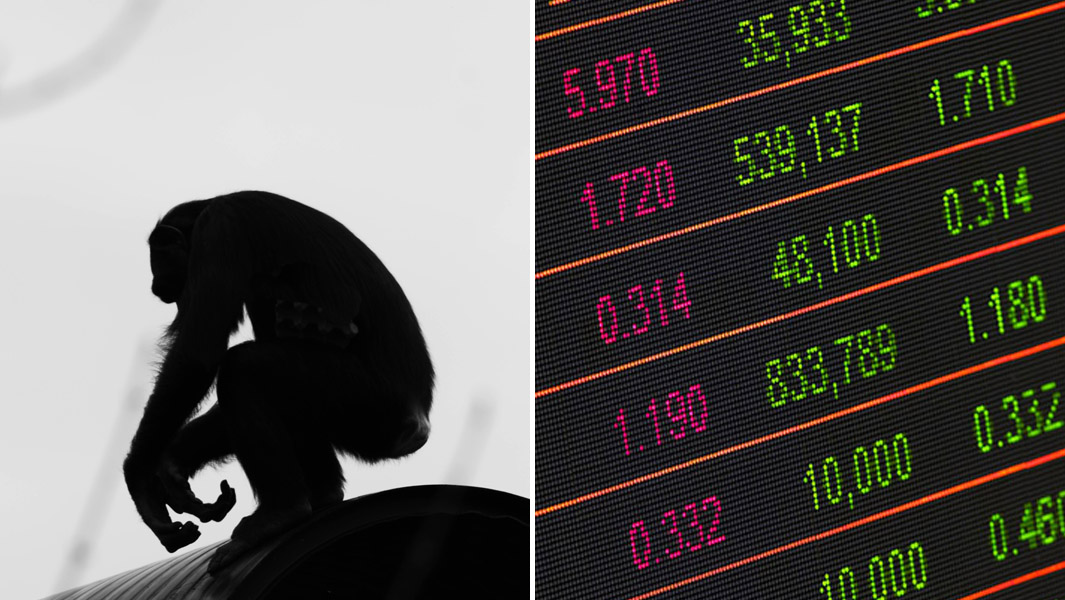The bizarre story of the chimpanzee that outsmarted Wall Street

Wall Street is a jungle.
That might explain why, in 1999, a particularly talented primate felt perfectly at home in the stock trading business.
The New York Stock Exchange (NYSE) is the world’s largest equities marketplace, and holds the record for the largest annual trading volume (achieved in 2002).
However, as the world prepared for a new Millennium, the world’s biggest stock exchange market saw the rise of a new pro player.
Meet Raven Thorogood III. Formerly a Hollywood star, in 1999 Raven ranked among the top 22 brokers in Wall Street. His stock index, MonkeyDex, soared with an impressive 213% gain, outperforming most seasoned brokers in the game.
Raven invested in 10 internet companies and outsmarted the majority of experienced brokers in the room.
Raven was a chimpanzee.

It all began on 7 January 1999.
The last year of the millennium had just begun when Raven stepped into New York's NYSE and embarked on his investment journey.
By throwing darts at a board, the five-year-old chimpanzee selected 10 stocks listing 133 internet-related companies.
Of course, a team of experts (including Hollywood’s animal trainer David Allensberry) was at hand to help the ape with his serendipitous selection.
As reported by Roland Perry, editor of the Internet Stock Review, the team adjusted the prices to reflect the start of the year to provide easier year-to-date comparisons with the traditional market indexes.
Although he was new to the world of stocks, before venturing into brokerage Raven had an illustrious entertainment career: reported in Bloomberg’s press release, the ape had “starred in three feature films, several TV specials and numerous commercials”.

The 10 chosen companies (which did not include numerous missed throws) formed MonkeyDex, an index of publicly traded internet and “new economy” stocks.
Raven’s portfolio featured then-popular tech companies like Inktomi, Lycos, and CMGI:
- AudioHighway (Nasdaq: AHWY)
- CMGI (Nasdaq: CMGI)
- iMall (Nasdaq: IMAL)
- Inktomi (Nasdaq: INKT)
- Kushner-Locke (Nasdaq: KLOC)
- ISSX Group (Nasdaq: ISSX)
- Lycos (Nasdaq: LCOS)
- NetSpeak (Nasdaq: NSPK)
- OnSale (Nasdaq: ONSL)
- OzEmail (Nasdaq: OZEMY)
During the last 12 months of the 20th century, the finance world sat at the edge of its seat for the ultimate showdown: The Chimp vs. Wall Street.

During the late 1990s, with the Dot Com Bubble ballooning uncontrolled and the value of internet companies rising steeply, most finance advisors would have suggested investing in internet stocks.
In his own way, Raven rode the wave brilliantly.
"He has talents far beyond what we ever dreamed possible and we feel certain that his picks will surprise many on Wall Street," declared Perry in Bloomberg's press release.
"Only time will tell how his picks pan out, but this much we can say – he is storming right out of the gate with picks like CMGI, which is up 95% in six trading days (...way to go, Raven)."
Indeed, Raven’s picks proved to be bountiful.
“Amazingly, Raven the Chimp is still very much in the running for the 1999 championship, currently beating five of America's top six internet fund managers […]. Moreover, it looks like he may well beat virtually all other technology funds,” writes MarketWatch in an article dated October 1999.
Our hero had no strategy, no idea of the market’s modus operandi, and no idea what the Nasdaq even was – yet he outperformed over 6,000 finance pros.

By the end of the decade, the MonkeyDex portfolio could boast a jaw-dropping return of 213%, surpassing the Nasdaq’s 86% gain rate for that year.
“The dart-throwing chimpanzee won. And big. He didn’t just beat all internet and technology funds. He beat all 10,000 mutual funds. Raven the chimp is now Raven the Champ!” wrote MarketWatch in December 1999.
“His Monkeydex Index beat the best-of-the-best of all mutual funds run by America’s top managers.”
Although he didn't have any prior (or present) knowledge of internet companies, Raven’s winning streak and rising gains soon proved that he was no lame duck.
He was, in fact, the most successful chimpanzee on Wall Street.

Most of you will ask: how could a chimp outsmart the wolves of Wall Street?
According to many, Raven’s success was largely the result of beginner’s luck combined with the rapid rise of tech start-up companies (and their stocks) during the expansion of the World Wide Web.
Within the ambitious walls of the NYSE, where capital exchanges hands at the speed of light, success is a volatile matter. That is especially true during a fruitful bubble that is, eventually, destined to burst.
Between 1995 and the early 2000s, tech companies and startups saw skyrocketing valuations, attracting significant investments and – consequently – attracting capital.
In such an optimistic climate, as everyone wanted to get their hands on tech companies, picking almost any internet-related stock meant easy wins and substantial financial gain.

However, the bubble was bound to burst.
By March 2000, the exuberance of the late 1990s gave way to the Dot-Com Crash: the winds changed, and Raven’s portfolio started its inevitable decline. The Nasdaq plunged nearly 70% over the next two years.
While a few of those early internet companies consolidated into today’s giants (Amazon and eBay, for example), a large number of the early startups that saw stellar gains during the boom went bankrupt.
Others, like Inktomi, the Internet provider company in Raven's portfolio, were acquired by bigger firms; in Inktomi's case, the business was acquired by Yahoo! in 2003.
Although the market crash would later allow the re-investment and stabilisation of internet giants as we know them today, it meant immediate and dramatic losses of capital as multiple investors lost the majority of their previous gains.
By August 2000, MonkeyDex was down 34%.
Ever heard of Raven, the most successful chimpanzee on Wall Street?
— Guinness World Records (@GWR) July 18, 2023
In 1999, she created her own index, dubbed MonkeyDex, and delivered a 213 per cent gain, outperforming more than 6,000 professional brokers on Wall Street. pic.twitter.com/usbDHndNPm
As the old saying goes: “Any fool can make money, but it takes a wise man to keep it.”
Of course, despite being named among the top-picking investors of the year and “making a monkey out of every darn (so-called) ‘professional’ money manager on Wall Street and everywhere in America”, Raven wasn’t methodically analysing balance sheets or forecasting growth trends.
The chimp’s dart-throwing method was based on luck and lacked two vital elements: strategic choices and the prudence necessary to navigate the market downturn.
Although no one expected Raven’s success to stem from keen analysis or market insight, his story was a perfect storm of hype and timing.
It proved that, in a frenzy-driven market, even random selections could bring meteoric gains — for a while, at least.
By October 2002, the NASDAQ registered abysmal losses: down 78% from the peak of 10 March 2000.
At the end of 2002, virtually nothing remained of Raven’s profits and MonkeyDex, once a celebrated success, vanished along with its website and the portfolio’s value.
No monkey business, indeed.
Looking for more American records and curiosities?
Check out the Superlative States archive for incredible records from the United States.



